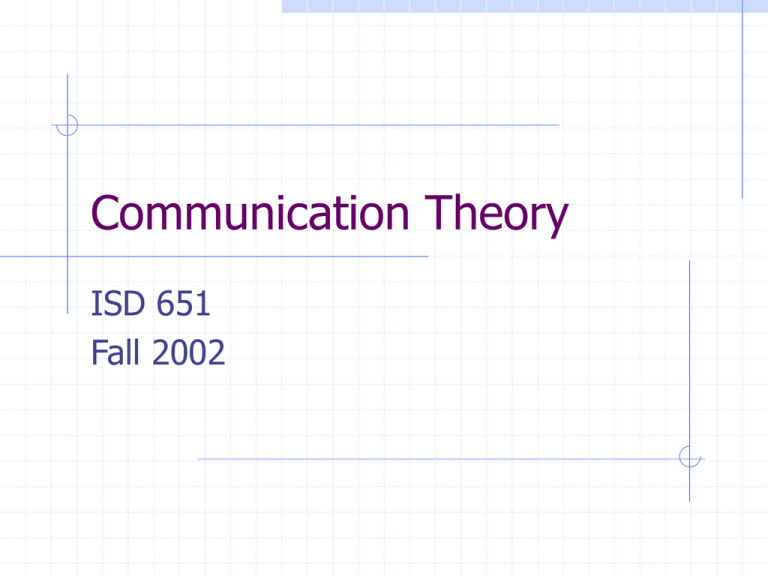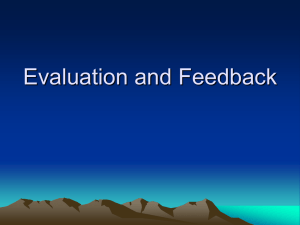Communication Theory - University of South Alabama
advertisement

Communication Theory ISD 651 Fall 2002 Communications Theory The theory of how messages are communicated between two entities, including how messages are sent and received, and factors that can influence or affect changes in the meaning of message throughout the process. Main Points – Shannon Weaver Model A linear view of communication: messages are encoded by a source and sent through a channel. Messages are then decoded by a receiver, who then sends the source feedback. Messages may be disrupted by noise. Schramm adds the factor of fields of experience of the sender and receiver, life experiences which can enhance communication when they overlap. Theoretical and Practical Applications Communications theory identifies the means, methods, and elements of communication and feedback. Main People Claude Shannon – Developed the initial theory of communication. With Warren Weaver developed the Shannon-Weaver model of Communication Theory W. Scramm – Added concept of field of experience to Shannon-Weaver model David Berlo – Developed SMCR model, stressing relationship between source and receiver Howard Lasswell – Introduced content analysis Relationship to Instructional Design Communication theory is a driving force behind instructional design. Instruction is designed so that its objectives can be properly communicated and received by the learner. Both the learner and the designer receive feedback about the instructional process. Incorporation Into Dick & Carey Incorporate more learner analysis to include culture, physical disabilities, learning styles Provide pre-assessment of learner cognitive styles Allow learner control, e.g. sequence Select media, colors, graphics appropriate to the learner’s specifics Select language level appropriate to learner Consider multiple versions of assessments taking into account learner characteristics Pictures are more memorable than words Websites http://www.exploratorium.edu/complexity/Co mpLexicon/Shannon.html http://www.cultsock.ndirect.co.uk/MUHome/c shtml/index.html http://collaboratory.nunet.net/dsimpson/comt heory.html http://art3idea.ce.psu.edu/art3/lessons/lesso n_4.html - Aretha Franklin - Communications Theory relationship http://www.aber.ac.uk/media/Documents/sho rt/trans.html Innovative Applications Use innovative technology to allow the learner to select the type of media, use interactive design, etc. Example of new technology – 3D word maps in the visual thesaurus References Message production : advances in communication theory / edited by John O. Greene., Mahwah, N.J. : Erlbaum, 1997. Watershed research traditions in human communication theory / edited by Donald P. Cushman and Branislav Kovaci´c. Albany, N.Y. : State University of New York Press, c1995. Modern digital and analog communication systems / B.P. Lathi. Philadelphia : Holt, Rinehart, and Winston, c1989. Human communication theory / Sarah Trenholm. Englewood Cliffs, N.J. : Prentice-Hall, c1986. Communication theory and interpersonal interaction / selected proceedings from the Fourth International Conference on Culture and Communication, Temple University, 1981 ; edited by Sari Thomas. Norwood, N.J. : Ablex Pub. Corp., c1985.






